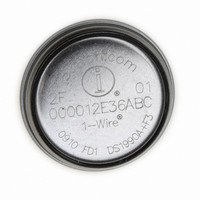DS1922T-F5# Maxim Integrated Products, DS1922T-F5# Datasheet - Page 35

DS1922T-F5#
Manufacturer Part Number
DS1922T-F5#
Description
IBUTTON TEMP LOGGER
Manufacturer
Maxim Integrated Products
Series
iButton®r
Datasheet
1.DS1922L-F5.pdf
(52 pages)
Specifications of DS1922T-F5#
Rohs Information
IButton RoHS Compliance Plan
Memory Size
512B
Memory Type
NVSRAM (Non-Volatile SRAM)
Lead Free Status / RoHS Status
Lead free / RoHS Compliant
While a mission is in progress or while the device is
waiting for a temperature alarm to start a mission, peri-
odically a temperature sample is taken and logged.
This “internal activity” has priority over 1-Wire communi-
cation. As a consequence, device-specific commands
(excluding ROM function commands and 1-Wire reset)
do not perform properly when internal and “external”
activities interfere with each other. Not affected are the
Start Mission, Forced Conversion, and Clear Memory
commands, because they are not applicable while a
Table 3. Memory Access Conflicts and Solutions
Write Scratchpad
Read Scratchpad
Copy Scratchpad
Read Memory with
CRC
Stop Mission
COMMAND
Memory Access Conflicts
______________________________________________________________________________________
The CRC-16 at the end of the command flow reads
FFFFh.
The data read changes to FFh bytes or all bytes
received are FFh, including the CRC at the end of
the command flow.
The device behaves as if the authorization code or
password was not valid or as if the copy function
would not end.
The data read changes to all FFh bytes or all bytes
received are FFh, including the CRC at the end of
the command flow, despite a valid password.
The General Status register at address 0215h reads
FFh or the MIP bit is 1 while bits 0, 2, and 5 are 0.
Temperature Logger iButton with 8KB
INDICATION OF INTERFERENCE
mission is in progress or while the device is waiting for
a temperature alarm. Table 3 explains how the remain-
ing five commands are affected by internal activity, how
to detect this interference, and how to work around it.
The interference is more likely to be seen with a high-
sample rate (one sample every second) and with high-
resolution logging, which can last up to 600ms. With
lower sample rates, interference may hardly be visible
at all. In any case, when writing driver software it is
important to know about the possibility of interference
and to take measures to work around it.
Wait 0.5s, 1-Wire reset, address the device, repeat
Write Scratchpad with the same data, and check the
validity of the CRC-16 at the end of the command
flow. Alternatively, use Read Scratchpad to verify
data integrity.
Wait 0.5s, 1-Wire reset, address the device, repeat
Read Scratchpad, and check the validity of the
CRC-16 at the end of the command flow.
Wait 0.5s, 1-Wire reset, address the device, issue
Read Scratchpad, and check the AA bit of the E/S
byte. If the AA bit is set, Copy Scratchpad was
successful.
Wait 0.5s, 1-Wire reset, address the device, repeat
Read Memory with CRC, and check the validity of
the CRC-16 at the end of the memory page.
Wait 0.5s, 1-Wire reset, address the device, and
repeat Stop Mission. Perform a 1-Wire reset, address
the device, read the General Status register at
address 0215h, and check the MIP bit. If the MIP bit
is 0, Stop Mission was successful.
Data-Log Memory
SOLUTION
35












